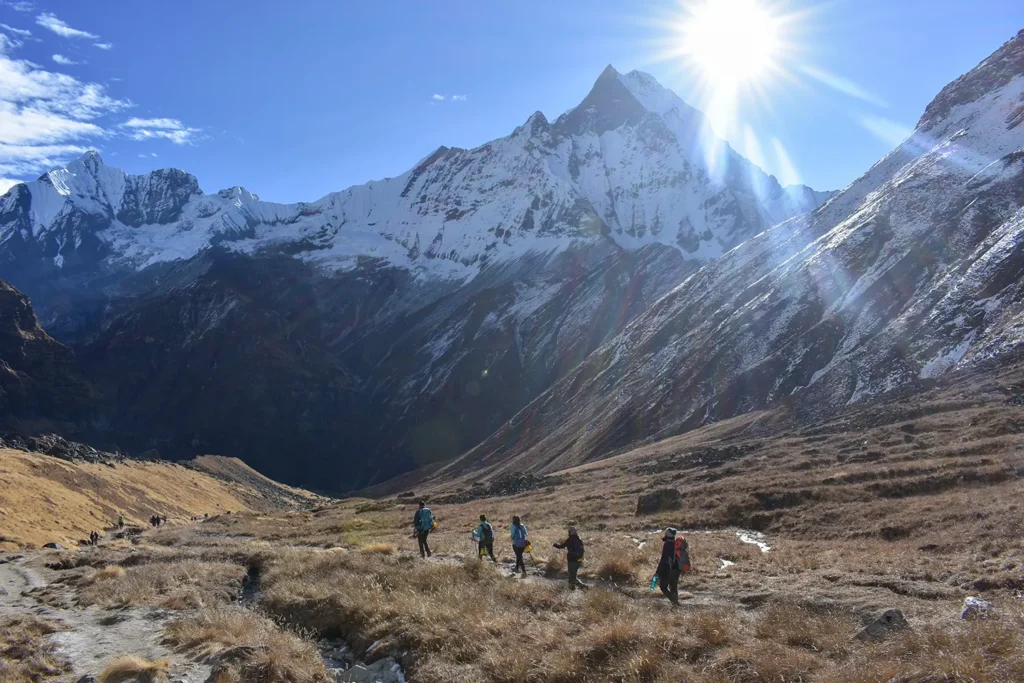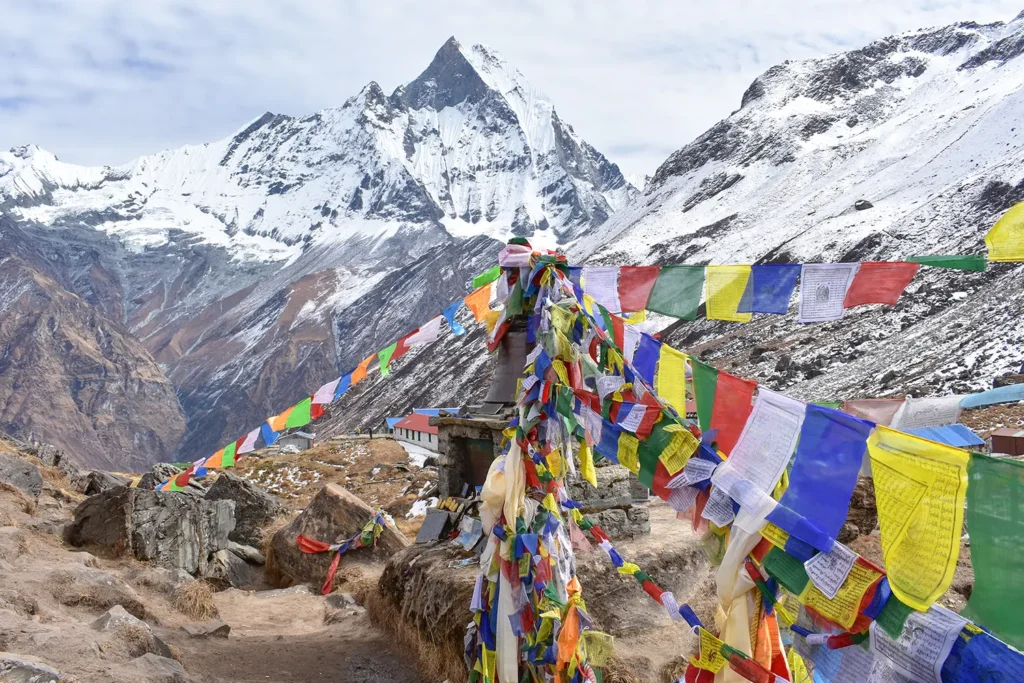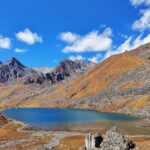Annapurna Circuit and Annapurna Base Camp Treks (ABC) in Nepal are two of the world’s most popular trekking routes. Nestled inside the Annapurna conservation area, the trails attract trekkers worldwide who come here to experience diverse sceneries and vistas, highlighting the region’s surreal natural beauty and cultural richness. Although these highly sought-after trekking destinations traverse similar terrain and landscapes, there are distinct differences between Annapurna Circuit and Annapurna Base Camp.
Trekkers encounter diverse experiences over a few days when they embark on ABC and Annapurna Circuit treks. From dense subtropical forests to adrenaline-pumping suspension bridges, from the grandeur of the world’s tallest mountains to slow life in the highlands of the Himalayas, both trails provide a classic trek experience Nepal is renowned for. So how do these trails differ and what unique experiences do they offer? Let’s find out the difference between the thrilling Annapurna Circuit and the popular Annapurna Base Camp treks.
Here is a detailed comparison between two of the most loved treks in Nepal. This comparative blog will help you to make an informed decision between Annapurna Circuit and Annapurna Base Camp, based on your interest and preferences.
Table of Contents
- Annapurna Circuit vs Annapurna Base Camp Trek: Highlights
- Annapurna Circuit vs Annapurna Base Camp: Best time to visit, temperature and weather conditions
- Annapurna Circuit vs Annapurna Base Camp: Difficulty level, altitude, trek distance and duration
- Annapurna Circuit vs Annapurna Base Camp: How to reach, accommodations, food options, and permits
- Annapurna Circuit vs Annapurna Base Camp – Which classic Nepal trek to choose
Annapurna Circuit vs Annapurna Base Camp: Highlights

Annapurna Circuit Trek
One of the world’s greatest treks, Annapurna Circuit is renowned as a classic and offers an immersive experience of Nepal’s diverse and rich culture. Add the splendour of the big mountains, including the 10th highest Mt Annapurna dominating the skyline.
The celebrated Annapurna Circuit Trek circumvents Annapurna massif in its entirety, over a journey lasting 15 to 20 days.
The trek begins in Besisahar and traverses breathtaking landscapes with panoramic views of iconic Himalayan peaks like Annapurna Massif, Dhaulagiri, and Machapuchre.
One of the classic trails in Nepal, the trek climbs to the maximum altitude of 17,769 ft, offering the thrill of exhilarating Thorongla Pass. The adventure on this trek escalates when trekkers encounter jaw-dropping vistas at every turn, showcasing the world’s deepest gorge, the Kali Gandaki Gorge.
Annapurna Base Camp Trek

Annapurna Base Camp Trek (ABC) in Nepal is renowned worldwide for its spectacular views of the eight-thousanders and easy accessibility. As soon as you arrive in Pokhara, you are greeted with a magnificent view of the Annapurna mountain range. Annapurna Base Camp trek is truly breathtaking, providing stunning vistas of the majestic Himalayas.
On the first day, you will be bowled over by the stunning Annapurna massif in addition to Machapuchre and Himchuli. You encounter the exotic and captivating views of Annapurna 1, Annapurna 2, Annapurna Glacier, Himchuli, and Mahcapuchre from unprecedented distances. What makes this a coveted experience is trekkers can go all the way to the base of the massive Mount Annapurna.
The trek offers a diverse landscape Nepal is known for. From dreamy mountainscape to tranquil village life to the rich culture of Nepal, ABC Trek offers it all.
Annapurna Circuit vs Annapurna Base Camp: Best time to visit | Temperature and weather conditions
Best time to visit Annapurna Conservation Area
Annapurna Circuit and Annapurna Base Camp treks lie in the Annapurna region of Nepal. This region of Nepal experiences pleasant weather and manageable temperatures during spring and autumn, making these two seasons the most popular months to explore the trekking trails inside Annapurna Sanctuary. The best time to visit Annapurna base camp and Annapurna Circuit is between March and May, and September to November.
Trekking to the Annapurna region in spring

Spring season kicks off in March and continues till early May. The season features bright sunny days and clear blue skies offering optimal trekking conditions. Plan this trek in the late spring to witness the vibrant rhododendron blooms along the trail. Also prepare for occasional snowfall as the season has a high probability of snowfall, especially in higher elevations.
Trekking to the Annapurna region in autumn
September marks the beginning of the autumn season in Nepal. People all across the world throng the Himalayan country to experience the classic tea house treks. Autumn season marks clear weather and an ideal time to witness the grandeur of big mountains.
Temperature and Weather Conditions
Annapurna Region experiences mild temperatures and delightful weather during the spring and autumn seasons. While both the trekking routes experience a similar range of temperatures, Annapurna Circuit tends to get colder in autumn seasons as you climb to higher altitudes.
Annapurna Circuit temperature ranges between 10°C to 25°C during the day in lower regions. The temperature drops to -10°C at higher elevations in spring months.
Autumn months start in September and continue till the first week of November. Expect temperatures between 10°C and 20°C in lower regions and -10°C to 10°C in higher regions.
Annapurna base camp temperature fluctuates between – 4°C and 8°C during the autumn months of September to November. Spring season registers warmer temperatures between 0°C to 10°C.
Annapurna Circuit vs Annapurna Base Camp: Difficulty level | Altitude | Trek distance and duration
Difficulty level
Annapurna Circuit Trek is considered the most difficult one compared to Annapurna Base Camp Trek, considering the longer trekking days and strenuous trails.
It is difficult as you set off on a multi-day trek, spanning over 15 to 21 days, depending on the route you select. As the trail traverses difficult mountain terrain and high-altitude regions, trekkers must be in good physical condition to trek comfortably to Annapurna Circuit.
Its contemporary, Annapurna Base Camp is a moderate trek and takes 8 to 10 days to complete. The trail winds through a mix of easy to moderate terrain passing through beautiful Nepali villages. The last stretch of the trek to the base of Mt Annapurna is a difficult climb as you climb to 4000ft above sea level.
Altitude
The altitude difference between Annapurna Circuit and Annapurna Base Camp is approximately 4000 ft. When you reach the base camp of Mt Annapurna, the highest point on the trek, the elevation gain is 13,500 ft. On Annapurna Circuit Trek, the highest elevation you climb to is 17,000 ft when you are at Thorong La Pass, a high altitude pass situated at 17,769ft. Traversing the altitude on the Annapurna Circuit Trek is more strenuous and demanding than the Annapurna Base Camp Trek.
Trek distance and duration

Annapurna Circuit Trek distance is between 145 km and 200 km depending on the route you follow. You will walk for a minimum of 5 to 8 hours every day, covering 10 to 20 km. It takes 15 to 20 days to complete the Annapurna Circuit trek, including travel to and from the base camp.
The total distance of the Annapurna Base camp trek is around 70 km. The average distance you will cover is 6-10 km per day. You will walk for a minimum of 5 hours every day. The longest day is day 7 of the trek. It takes 9 days to complete the Annapurna Basecamp trek, including travel to and from the base camp.
Annapurna Circuit Trek is a multi-day hike, covering longer distances and requires more days to complete than the Annapurna Base Camp trek.
Annapurna Circuit vs Annapurna Base Camp: How to reach | Accommodations | Food Options | Permits
How do you reach the base camp of Annapurna Circuit Trek?
For all Nepal treks, first reach Kathmandu, the capital city of Nepal. Kathmandu is well connected by air with major international airports. Though Annapurna Base Camp and Annapurna Circuit Treks are located inside Annapurna Sanctuary, ABC Trek is easily accessible.
Annapurna Circuit trek begins in Besisahar and Annapurna Base Camp trek starts from Ghandruk village, 2 hrs from Pokhara.
To start the Annapurna Circuit trek, fly to Kathmandu, followed by a road journey to Besishahar. Some trekkers also drive further to Chame and begin the trek. The trek begins in Besishahar and concludes in Pokahara. It takes 7 to 8 hrs to reach the starting point of the trek from Kathmandu on a shared jeep or a bus. For a comfortable journey, you can book a private taxi. It costs you 140 to 180 USD.
How do you reach the Annapurna Base Camp Trek?
If you are embarking on the Annapurna Base Camp trek, reach Kathmandu first. From Kathmandu, fly to Pokhara, the quickest way to reach Pokhara. It is a 40-minute flight from Kathmandu to Pokhara. Flights fly daily on this route between 8.00 a.m. and 3.00 p.m.
We recommend you fly to Kathmandu and then take a bus/shared cab to Pokhara for Annapurna Base Camp Trek for an economical travel option.
As Pokhara is a renowned tourist hotspot, regular buses leave from Kathmandu every 15 minutes. The first bus starts as early as 7.00 AM. Tourist buses cost between NPR 800-1200 per person and a ticket in a local minibus costs between NPR 400-600 per person. Nepali Rupee is cheaper than Indian Rupee and one Indian rupee equals 1.60 Nepali Rupee. The duration of the drive is between 6 and 8 hours.
Travel plan from India to Kathmandu
The most convenient and efficient way to travel to Kathmandu is by air. You might be surprised to know that the distance between the capitals of India and Nepal can be covered in just one and a half hours by air. If you plan your trip well in advance, you can book a flight from Delhi to Kathmandu between INR 12-15K. Major airlines such as Indigo, Air India, and Vistara provide direct flights from Delhi to Kathmandu.
Here is the current cost of flights from major Indian cities to Kathmandu for April. The fare surges further if you postpone your booking.
- Delhi to Katmandu – ₹ 12,050
- Mumbai to Kathmandu – ₹ 16,149
- Bangalore to Kathmandu – ₹ 19,858
- Hyderabad to Kathmandu – ₹ 24,777
Flying from Delhi is the cheapest option to reach Kathmandu
Only Delhi and Mumbai have direct flights to Nepal’s capital. Other cities like Bangalore, Hyderabad and Kolkata have connecting flights to Kathmandu.
Where to stay in Kathmandu?
The capital city of the Himalayan country is also a tourist hub frequented by explorers from across the world. After you land in Kathmandu, take a room in Thamel, a buzzing, visitor-friendly area and a commercial neighbourhood located in Kathmandu. Thamel is well connected to other parts of Nepal.
There is an array of options for staying in Kathmandu. You can settle for a night in a hostel or book a room in a hotel. If you are looking for hostels in the Thamel region, visit Hostelworld’s website to check the availability.
Accommodation on Annapurna Circuit Trek vs Annapurna Base Camp
Like most treks in Nepal, trekking in the Annapurna region offers a comfortable stay in tea houses. Whether heading to Annapurna Circuit or Annapurna Base Camp, trekkers enjoy comfortable and cosy tea houses along the trail. The accommodation is similar on both routes and provides well-established tea houses with attached bathrooms and hot showers. The teahouse bedrooms usually have only two beds and basic amenities such as mattresses, sheets, pillows, and blankets are available.
As you gain elevation, the facilities are basic and toilets are shared, but the grandeur of the mountains remains constant from these tea houses. Tea houses in Nepal offer a unique stay experience. The tea houses come in different sizes, some are big and spacious, while others are small and can only accommodate a few trekkers.
What are the toilet and shower facilities in the tea houses?
Tea houses have Western-style toilet facilities, but as you ascend, you may encounter Indian-style commodes instead of flush toilets. It’s important to note that flush toilets are unavailable in the higher regions. However, basic toilet facilities will still be provided and trekkers use buckets to pour water.
Remember to carry your roll of toilet paper.
Is there a shower facility in the tea houses?
The shower facilities are available at the tea houses along the trail. Some of the tea houses include shower charges in the room tariff. Trekkers can also avail of the hot shower facility by paying an additional cost. The charges for hot water can vary between NPR 300 and 600.
Please note that shower facilities may be unavailable at higher altitudes. Therefore, if you wish to shower at higher elevations, you may need to purchase a bucket of hot water for bathing.
Please be aware that shower facilities may be unavailable at higher altitudes. Consequently, if you intend to clean yourself at higher elevations, you may need to purchase a bucket of hot water for bathing.
What is the daily cost for Annapurna Circuit Trek and Anapurna Base Camp Trek?
The daily cost for Annapurna Circuit and Annapurna Base Camp treks depends on three primary factors – food, accommodations, permits and guide charges. The average daily cost is similar for both treks; however, the overall budget for Annapurna Circuit will be higher due to the greater number of trekking days.
Tea houses in the Annapurna region charge NPR 400 (USD 5) to NPR 1500 (USD 15) per meal. As you higher up, the cost of meals also increases.
For accommodation on Nepal Treks, trekkers pay NPR 600 ($5) to NPR 1200(USD 10) per night. The tariff for rooms also increases as you trek to higher elevations. Tea houses charge up to NPR 1800 for a single room at higher camps.
Trekking in the Annapurna Region requires trekkers to obtain permits and hire a guide. The permit charges will be one one-time payment of NPR 2,000/ USD 17 for a TIMS Card and NPR 3,000/ USD 25 for the Annapurna Conservation Area Permit.
Another major expenditure is guide charges while trekking to both Annapurna Circuit and Annapurna base camp treks. Hiring a licenced guide is mandatory for these treks if you are trekking solo. Guide charges constitute a significant portion of your daily expenses on Nepal treks.
Hiring a guide will cost you between NPR 2000 (USD 25 approx.) and 3500 (USD 30 approx) per day. The charges cover their daily expenditure, including food and accommodation etc.
If you are trekking with a trekking company, the guide charges are typically included in the total trek cost.
What permits are required to trek in Annapurna Sanctuary?
Nepal Government has mandated the permits to trek in the Annapurna region.
Trekking to Annapurna Circuit Trek and Annapurna Base Camp trek requires two permits – ACAP and TIMS Card.
Both Annapurna Circuit and Annapurna Base Camp Trek are located inside the Annapurna Conservation Area, hence trekkers require an Annapurna Conservation Area Permit (ACAP) to attempt these treks.
Trekkers can rely on their tour operator or tour guide to acquire the permits.
- Annapurna Conservation Area Permit Cost
| SAARC nationals | NPR 1,000/USD 7.50 |
| Non – SAARC nationals | NPR 3,000/USD 25 |
You can collect the Annapurna Conservation Area Permit from
- Tourist Service Centre in Kathmandu
- National Park and Wildlife Conservation Department in Kathmandu
- ACAP office in Pokhara
- Tourism Board Office in Besisahar or Pokhara
- Trekking Information Management System (TIMS) Card
| SAARC nationals | NPR 1,000 /USD 7.50 |
| Non – SAARC nationals | NPR 2,000/USD 17 |
Trekkers can collect their TIMS card on arrival in Kathmandu from the Tourist Service Centre in Kathmandu located on Pradarshani Marg. You can also collect the card from the Department of Wildlife Conservation in Kathmandu.
Remember to carry passport-size photos for the permit. The fee is payable in Nepali Rupees.
Food on Annapurna Circuit Trek vs Annapurna Base Camp Trek
Tea houses on all Nepal treks offer similar meal options. The food options on both the treks are alike.
Thakali Thali, a staple in Nepali cuisine is the most popular and easily available. This local thali is a combination of Daal (lentils), Bhaat (rice), and Tarkari (vegetable curry) with a side of green veggies, pickles, and some local delicacies.
You can eat Thakali Thali for lunch and dinner on most days as they are filling and are served fresh. Breakfast will have options of bread, eggs, porridge etc.
If you wish to order anything outside this staple meal, teahouses offer a wide range of meal options – from Pizza to Pasta. However, these will come at an additional cost.
Mobile network, charging points and Wifi on Annapurna Circuit Trek vs Annapurna Base Camp
There will be a scanty mobile network on both Annapurna Base Camp and Annapurna Circuit. You can buy an N-cell SIM card in Kathmandu to access the mobile network in the lower regions. However, as you climb higher up the network becomes poor and scanty. Electricity is limited to overhead lamps. Tea houses along the trail rely on solar power, hence there are limited charging points.
Charging points for mobile and Wi-Fi are available at some teahouses at an additional cost. The facilities are available in the lower regions. The charges for wifi start at around NPR 200 and go up to NPR 600. The charges become expensive as you go higher up.
Do not expect a high-speed WIFI connection on the trek. These facilities become scarcer as you climb higher up in the mountains.
Annapurna Circuit vs Annapurna Base Camp – Which trek to choose?
As the two most popular treks lie in the Annapurna Sanctuary, trekkers encounter a slight difference in experience and landscapes. Annapurna Circuit trek circumvents the Annapurna massif while the Annapurna Base Camp takes you to the base of one of the most notorious mountains in the world. Choosing between the two should be based on your preference, number of days in hand, and physical fitness.
Embark on Annapurna Circuit Trek to experience the diverse culture of Nepal if you can spare a minimum of 12 to 15 days. Additionally, the trek traverses higher elevations and extends to more days, therefore, your fitness should be optimal to navigate the high altitude pass and longer trekking distance.
Annapurna Circuit trek also offers magnificent views of Mt Dhaulagiri and Manasalu, the 6th and 8th highest peaks. The trek also traverses the arid landscapes of Lower Mustang and the world’s deepest gorge, Kali Gandagi Gorge, something you miss on the ABC trail.
Annapurna Base Camp offers equally spectacular sceneries and is comparatively easier. The trek traverses varied landscapes of Nepal over 9 trekking days and takes you to the base of the World’s tallest mountain, Mt Annapurna.
While choosing between the two can be challenging, both trails offer epic trekking experiences Nepal is known for. Whether you opt for the popular Annapurna Base Camp or the thrilling Annapurna Circuit, you will return home with unforgettable memories.





